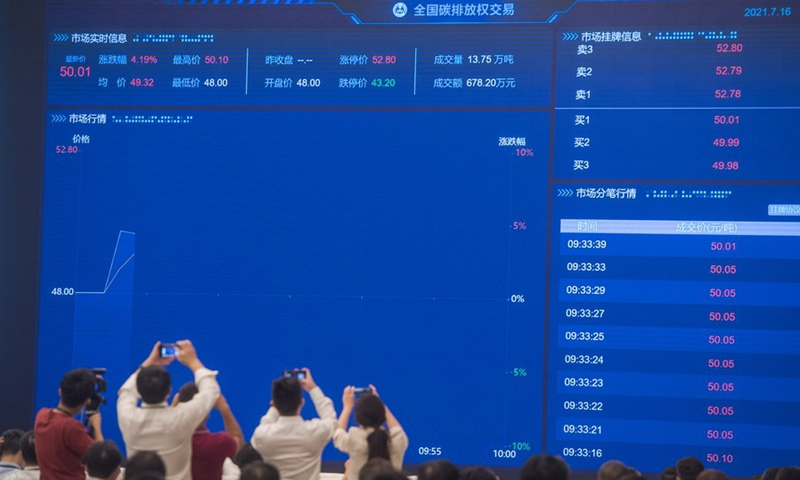China issues 17-point guideline to advance low-carbon transition, accelerate building of national carbon trade market

Photo taken on July 16, 2021 shows a screen displaying real-time information of national carbon emission trading in Wuhan, central China's Hubei Province.(Photo: Xinhua)
China on August 25, 2025 issued a 17-point guideline on promoting the nation's green transformation and the building of a national carbon emissions trading market, as part of the country's broad efforts to achieve the goals of reaching peak carbon emissions and carbon neutrality.
The guideline, jointly issued by the General Office of the Communist Party of China Central Committee and the General Office of the State Council, aims to promote the construction of a more effective, dynamic and internationally influential national carbon market, according to the Xinhua News Agency.
By 2027, China plans for its national carbon emissions trading market to cover all major industrial emitters, with voluntary greenhouse gas reduction trading fully covering key areas. By 2030, it aims to establish a totally quota-based market combining free and paid allocations, alongside a credible, transparent, and internationally aligned voluntary reduction market with clear pricing, strong regulations, and effective emission reductions, said the guideline.
The guideline calls for expanding the coverage of the national carbon emissions trading market. Industries and types of greenhouse gases will be gradually included in an orderly manner, based on factors such as industry development, contribution to carbon and pollution reduction, data quality, and emission characteristics.
China will enhance its carbon quota management system and establish a carbon emission quota management system with clear expectations, openness and transparency to maintain policy stability and continuity. It will clarify medium- and long-term carbon emission quota control targets, while taking into account economic and social development, industry characteristics, and the cost of low-carbon transformation.
The guideline emphasizes enhancing carbon emissions trading market vitality by diversifying trading products, expanding trading participants, and strengthening market supervision. A comprehensive management and support system will be established to improve overall market governance.
The carbon emissions trading market is an important policy tool for addressing climate change through market mechanisms and accelerating the green transformation of China's economy and society. China has built a national carbon emissions trading market for key emission units to fulfill mandatory reduction obligations, as well as a nationwide voluntary greenhouse gas reduction trading market to incentivize social self-reduction efforts, according to the guideline.
Launched in July 2021, the cumulative quota trading volume reached 630 million tons, with a cumulative trading volume of 43.033 billion yuan as of the end of 2024, according to the Xinhua News Agency.
According to data released by the National Bureau of Statistics (NBS) on February 28, preliminary calculations indicate that carbon emissions per 10,000 yuan of GDP dropped 3.4 percent year-on-year.
Facing tighter environmental constraints, China is coordinating carbon reduction, pollution control, green expansion, and growth, steadily advancing goals of carbon peaking and neutrality, accelerating green development, and strengthening the green foundation for high-quality growth, said NBS deputy head Sheng Laiyun, according to Xinhua.
Production credits: This publication is produced by Global Times.
Disclaimer: At the Ghana Centre for China Studies we eschew specific policy positions. All positions and opinions expressed in this publication are solely those of the author (s).